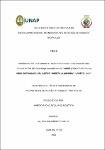Dinámica del crecimiento, sobrevivencia y calidad de una plantación de Cedrelinga cateniformis D. Ducke (fabaceae) en un área degradada del CIEFOR “Puerto Almendra”, Loreto. 2023
Abstract
The study was conducted at the facilities of the Forestry Research and Teaching Center CIEFOR "Puerto Almendra" and the project "Provenance trials of forest and agricultural species of the Peruvian Amazon" attached to the National University of the Peruvian Amazon (UNAP) through the Faculty of Forestry Sciences, located in the district of San Juan Bautista, province of Maynas, Loreto region. The main objective was to know the dynamics of growth, survival and quality of a plantation of Cedrelinga cateniformis D. Ducke (Fabaceae) in a degraded area of CIEFOR "Puerto Almendra". The results report that the greatest increase in diameter was recorded in subplot 3, with a value of 2.79 cm increase at the end of the evaluation period. On the other hand, the greatest increase in height occurred in subplot 1, with a value of 104.58 cm increase at the end of the evaluation period. Likewise, there was a 73% survival rate of "tornillo" plants at the end of the evaluation period, while mortality reached 27% respectively. Finally, according to the coefficient of variation of the number of plants per hectare, the value of 13.66% indicates that the plantation has an acceptable quality. El estudio fue realizado en las instalaciones del Centro de Investigación y Enseñanza Forestal CIEFOR “Puerto Almendra” y del proyecto “Ensayos de procedencias de especies forestales y agrícolas de la Amazonía Peruana” adscritos a la Universidad Nacional de la Amazonía Peruana (UNAP) a través de la Facultad de Ciencias Forestales, ubicada en el distrito de San Juan Bautista, provincia de Maynas, región Loreto. El objetivo principal fue conocer la dinámica del crecimiento, sobrevivencia y conocer la calidad de una plantación de Cedrelinga cateniformis D. Ducke (Fabaceae) en un área degradada del CIEFOR “Puerto Almendra”. Los resultados reportan que el mayor incremento en diámetro se registró en la subparcela 3, con un valor de 2,79 cm de incremento al término del periodo de evaluación. Por otro lado, el mayor incremento en altura se presentó en la subparcela 1, con un valor de 104,58 cm de incremento al final del periodo de evaluación. Así mismo, se registró un 73% de sobrevivencia de plantas de “tornillo” al término del periodo de evaluación, mientras que la mortalidad alcanzó un 27% respectivamente. Finalmente, de acuerdo con el coeficiente de variación del número de plantas por hectárea, el valor de 13,66% indica que la plantación tiene una calidad “aceptable”.
Collections
- Tesis [407]


